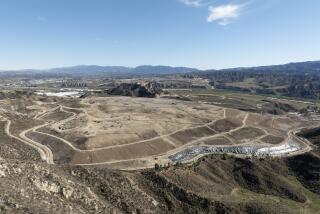Topics / LANDMARKS : High-Octane History
- Share via
At first glance, the tiny red-and-white gas station looks like a movie set for a period film about small-town America.
There are just three pumps, with a small, hand-painted “full-service” sign propped atop the middle one. Not one electronic-payment machine is in sight. And attendants, with aim-to-please faces, actually speak to and dote on drivers who pull into the station: wiping their car windows clean, looking under the hood and sending them off with “Thanks . . . Have a good one.”
But this is no Hollywood illusion. There is gas in them there pumps and Canyon Service, a 70-year-old institution that local historians believe is the oldest, continuously operating gas station in Los Angeles, has survived the self-serve gas revolution unscathed.
The decline of full-service gas stations is a nationwide trend. In 1972, more than 226,000 traditional full-service stations existed in the country, according to industry observers. Today, fewer than half are still in business, although there are more than 70,000 self-serve mega-stations and about 70,000 stores that peddle gas.
But Canyon Service has carved a specialty market out of the intensely competitive gas business by carrying 100-octane gas, a cleaner, slower burning premium fuel that is preferred by drivers of high-end European sports cars, Harley Davidsons and dirt motorcycles. Only a handful of stations in Los Angeles carry such gasoline.
“It’s one of the few little niches left in this modernized world,” said Dennis Kahn, who sat on his Honda Nighthawk motorcycle while one of the attendants filled the tank with the high-octane fuel. “It’s like an antique gas station . . . sort of 1950-ish. And there is nothing within a 20-mile radius of here that carries 100 octane.”
Don Peterson, manager of the business at Entrada and Amalfi drives, said Canyon Service has become a sort of gas station to the stars. Santa Monica Canyon, thick with celebrity residents who inhabit sprawling mansions, supplies a steady stream of Porsches, Jaguars, BMWs and Mercedes. Not to mention Harleys.
“Jaime Lee Curtis, Jack Lemmon, Goldie Hawn, Ted Danson and Eddie Van Halen--he comes for gas here too,” said Peterson, who has leased the station since January from the owner, Angelina Marquez Olivera.
But beyond the 100-octane gas and occasional star sightings, the station, which was used as a backdrop in such feature films as “Lawnmower Man” and “Calendar Girl,” offers an even rarer product: service.
“It’s hard to find a full-service gas station in L.A.--period,” said Peterson, who runs the station with three employees. “We do the whole thing. Check the oil, wash the windows, check all the fluids, check the air in the tires, look under the hood. Just like the old days.”
Canyon Service’s Spanish Colonial revival building was built in 1926 by Perfecto Marquez, who raised his family in a tiny Craftsman-style house that sits behind the station.
A tiny building next to the gas station, no longer in use, housed a fruit and vegetable market that, in its heyday, bustled with shoppers.
The land was passed down to Perfecto Marquez and his siblings from his great-great-grandfather, Francisco Marquez, and Ysidro Reyes, his great-great-uncle. The two men had settled in the scenic coastal canyons with their families when California was still under Mexican rule, receiving 6,656 acres of land from Santa Monica Canyon to Topanga Canyon through a Mexican land grant known as Rancho Boca de Santa Monica in 1839.
Portions of the land were sold off beginning in 1979. What remains of the original land grant belongs to Marquez Olivera, believed to be the oldest living descendant of Francisco Marquez and the daughter of Perfecto Marquez. The 77-year-old woman still lives in the house that she was born in behind the gas station.
“The old-timers like my dad must have used the best material because . . . it’s still good for at least another 20 years,” Olivera said. “It’s like a part of a Raymond Chandler novel, who lived in the Palisades and very well could have used this gas station,” said amateur historian Randy Young. “It really is kind of amazing that the structure is the only remaining original portion of the land grant days.”
Young said that when Perfecto Marquez established the station, there was no other development in the area. The business was sustained by the heavy beach traffic, Young said.
In 1986, the station was nearly run out of town by homeowners who lived on the last remaining tract of land that Olivera sold to a developer in the 1980s. The station’s right to be there was challenged primarily on the basis of a zoning ordinance that prohibited gas stations in residential neighborhoods, said Young.
City zoning officials decided that the gas station was “grandfathered” because it had been in the canyon long before zoning existed. Olivera said that she was told the station can continue to operate as long as the property is owned by the descendants of the Marquez family.
“Here was one of the early Mexican families who founded L.A. getting pitched off their land. No one wanted to touch it,” Young said.
Doug Swanson, who has pumped gas at the station part-time for 10 years, marvels at Canyon Service’s endurance. A studio musician, he has gotten occasional work from celebrities passing through.
“As long as customers keep coming in . . . and because of this little community it serves and their support of small business, it will survive.”
More to Read
Sign up for Essential California
The most important California stories and recommendations in your inbox every morning.
You may occasionally receive promotional content from the Los Angeles Times.













